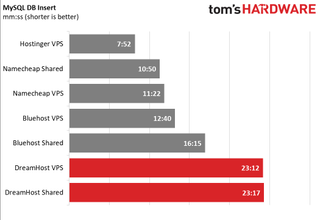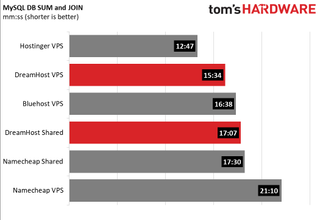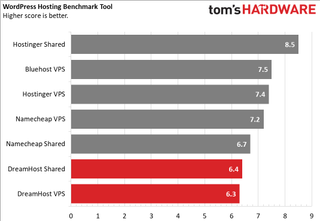Finding hosting for your website should be straightforward, whatever the size and scale of the project. Typically, you’ll be looking for VPS or shared hosting – both are suitable for all manner of web applications, from WordPress blogs to online stores and beyond.
But a cursory glance at a list of available web hosts offering both VPS and shared hosting plans reveals around 10 providers. Wherever you look, the names are the same, although the order might be a little different.
Companies like DreamHost have built their reputations on providing good hosting, competitive pricing, and reliable customer service. They make it easy to run WordPress sites, static websites, custom-built websites, e-shops, and pretty much any web project you can think of.
DreamHost, which began its hosting service in 1997, operates worldwide out of an HQ in California. Among other hosting options, DreamHost offers shared and VPS hosting plans. We were interested to find out if and how these stand out from other providers.
The shared hosting plan from DreamHost is typical, giving some disk space on a server for a small monthly subscription. Sharing that server with other low-budget websites comes with some caveats – the RAM and CPU resources are divided among the sites. This may seem like a good deal, and for smaller projects, it often works well. But when traffic spikes slow down the whole server (affecting the other sites) it’s a good time to move on. Upgraded shared servers are an option, as are VPS plans.
A VPS (Virtual Private Server) offers greater control over resources. The virtual hardware is dedicated to your project, rather than shared with others. It’s an advantageous arrangement, one that gives you better control of the server, and ultimately your website.
We tested DreamHost's $30/month VPS Professional plan and $4.95/month Shared starter plan, both of which are cheaper ($20/month or $2.59/month) if you pay for 36 months in advance. We found database and WordPress performance mediocre on both plans, though they were capable of handling a fair amount of traffic.
Most disappointing, however, was the unadvertised database size limit on the shared plan of 3GB, which caused DreamHost to start charging us an extra $15 a month for MySQL hosting. Whether judging via performance or price, DreamHost's plans don’t earn as spot on our list of best web hosting services.
Swipe to scroll horizontally
| Plan Name | VPS Professional | Shared Starter |
| Price per month | $30 | $4.95 |
| CPU | Row 2 - Cell 1 | N/A |
| RAM | 4GB | N/A |
| Storage | 120GB SSD | 50GB |
| Bandwidth | Unmetered | Unmetered |
| Database Limit | Unlimited | 3GB |
DreamHost VPS
An impressive collection of four VPS plans are available from DreamHost, each offering greater RAM and storage, and all with unlimited bandwidth.
We selected the VPS Professional plan for review. This virtual server hosting has 4GB of RAM, 120GB SSD storage, and unlimited bandwidth. CPU details are not shared on DreamHost's website, so I contacted the support team for further details on this matter:
“We don't place explicit limits on CPU, as individual VPS have higher and more focused memory requirements than CPU requirements,” a DreamHost rep told Tom's Hardware.
Other providers offer a specific vCPU (virtual CPU) speed, and that's often an attractive option. It’s useful for working out exactly what you’re getting, and what to expect. However, the response from DreamHost support makes sense.
Some hosting providers impose limits on the number of databases that can be created and accessed on a server. Shared hosting plans typically leave this as unlimited, or high enough that you wouldn’t reach it – remember the physical storage space is a limit – but VPS plans tend to be clearer. Again referring to the DreamHost support team, I learned “You can create as many databases as you would like with VPS Hosting.”
It’s good to see unlimited bandwidth being offered by DreamHost. Some competing providers charge for breaking the bandwidth limit, which often seems a bit mean.
DreamHost’s VPS plans also include access to its ChatGPT-4o-powered AI Business Advisor. This is integrated into the server’s control panel, which can assist with SEO challenges and generating content for your site’s social media presence. DreamHost emphasizes that the AI Business Advisor does not use your personal data to generate responses.
Swipe to scroll horizontally
| Price (monthly) | $10 | $20 | $40 | $60 |
| CPU | N/A | N/A | N/A | N/A |
| RAM | 2GB | 4GB | 8GB | 12GB |
| Storage | 60GB SSD | 120GB SSD | 240GB SSD | 360GB SSD |
| Bandwidth | Unlimited | Unlimited | Unlimited | Unlimited |
The four VPS plans from DreamHost can be signed up to a monthly rolling contract (prices as seen in the table) or with a yearly or 3-year contract, paid up front. These long-term options result in discounts ranging from 51% to 74%, so are worth considering if such an arrangement is part of your strategy. Note that when the term ends, the non-discounted renewal rate is applied, so you'llpay full price from that point onward.
DreamHost VPS plans offer various advantages over some competitors. These are managed servers, so the operating system (Ubuntu) is preinstalled and updates for the OS, PHP (support for PHP8), and WordPress are automatically installed.
These systems are configured to run scripts in Perl, Python, Node.js, and Ruby. You get access to Crontab, SSH access, and SFTP (unlimited user accounts). DreamHost VPS plans also get a choice of Apache or Nginx server software and a unique IPv4 address, plus unlimited IPv6 addresses.
DreamHost offers its own control panel software, DreamHost panel. This is intended to replace the common cPanel solution, and supports the importing of cPanel backups (although this is a time-consuming, manual process).

Overall, DreamHost Panel was relatively easy to navigate, though its dual system of tabs is a bit strange. There are some aspects of your account(s), such as email management, that you must navigate to through the left panel. For others, you must click Websites under Manage Websites on the left side, then select the site and navigate to the appropriate tab in the center window pane.

Still, with a little hunting around, we found all the important controls, including those for managing files, managing databases, and installing/uninstalling WordPress. The performance of the VPS plan was a mixed bag, as it was slower than the competition on two out of three MySQL database tests and on the WordPress Benchmark. However, it managed to handle 500 concurrent users with aplomb and hit middle-of-the-pack on the Website Speed Test.
If your budget doesn’t stretch to subscribing to a VPS and you need something simpler, the shared hosting plans from DreamHost are an option. Two of these are available, Starter and Unlimited, with a low monthly subscription cost and unmetered monthly traffic (see below).
As a shared hosting plan doesn’t have RAM or CPU requirements, the only hardware specification you’re going to need to be aware of is storage. DreamHost’s Shared Starter plan has a 50GB limit, while the Shared Unlimited plan has “unlimited” storage. Meanwhile, both also offer unlimited storage, and unlimited databases, but choosing the Shared Unlimited plan gets you the option to create unlimited websites and email accounts.
Swipe to scroll horizontally
| Price (monthly) | $4.95 | $8.95 |
| Storage | 50GB | Unlimited |
| Monthly Traffic Max | Unmetered | Unmetered |
| DB Size Limit | 3GB | 3GB |
The prices in the table are for the basic monthly rolling arrangement, which is advertised as “no commitments or contracts” and is ideal if you’re just dipping your toe into the world of running a website. However, if you want a longer deal, annual and tri-annual arrangements are available. These give you a hefty discount on the price, potentially saving between 63% and 72% on the basic monthly price. Note that once the chosen arrangement ends, the price goes up.
There are some really big gotchas here that you may not notice right away. First of all, the Starter plan does not come with email, something almost every plan on earth has included. For that, you have to pay an extra $1.67 a month.
But we found out about an even bigger surprise charge that we really did not like. In the spec sheet you see before you buy it, the DreamHost shared plan says 50GB of storage, but it neglects to mention that you can only have 3GB of database storage, the main kind of storage many people need. Just to run our database tests, we exceeded that 3GB limit, and rather than preventing us from uploading the larger amount, DreamHost (with some warning) created a new, $15/month MySQL VPS plan just to host our database. So all of a sudden, our $4.95 a month plan ended up costing $19.95 a month!
Apparently, DreamHost has a variety of these MySQL VPS plans which are designed just to host databases and none of them seems to be worth the money. These plans range from $15 for just 10GB of database storage to $100 for 120GB. You can get an entire VPS with the webserver and more database storage at many competitors – including Hostinger – for less than this. To be fair to DreamHost, the company did send us a warning email and gave us a few weeks to remove our data if we didn’t want to be automatically subscribed to the MySQL hosting on top of our shared plan. But this whole thing still smells very bad to us, particularly when other services don’t do this.
Shared hosting does give you free WordPress migrations using DreamHost’s own plugin, a free SSL certificate for your website, and automatic WordPress updates covering core functionality and security. Daily backups are included, and you can also access the server over FTP or SFTP. Some differences between the Shared Starter and Shared Unlimited are noticeable – for example, you get up to six FTP accounts with Starter, as opposed to Unlimited’s unlimited option. Similarly, Starter is limited to five subdomains and six MySQL databases.
As with the VPS plan we tested, the shared plan uses DreamHost’s own proprietary control panel. While not as intuitive or powerful as cPanel, the company’s solution gives you easy access to basic functionality such as setting up FTP or creating MySQL databases.
Database, WordPress and Scripting Performance
Features and price are just one aspect of assessing whether a web host and its most appropriate plan is the right fit for your project. How fast the server is, its ability to handle requests for HTML files, whether it can cope with a sudden uptick in visitors, and other performance factors are also important considerations.
But as you don’t get an idea of performance until you sign up and start using a host, we’ve done that bit for you. We’ve set up several tests on our chosen shared and VPS plans, using large sample databases and a fresh copy of WordPress with some dummy article content.
We start by running three database tests, using a MySQL database to see how quickly the plans process our queries. At test time, both DreamHost’s shared and VPS plans were running MySQL version 8.0, a fairly recent version of the popular DB software.
The first test inserts 87 million rows of data into the MySQL database. This is data taken from Tom’s Hardware’s own page view record. Performance is assessed on speed – the faster, the better.

Both the VPS and Shared plans were significantly slower than any of the competition. The process took a whopping 23 minutes and 12 seconds on VPS and a nearly identical 23:17 on shared. Either way, they are way behind both the shared and VPS plans from Namecheap and Bluehost. Hostinger’s VPS plan leads the pack and is almost 300% faster.
Pushing the test parameters, we added random numerical values into the data, again hoping for a fast conclusion to the test.

Here, DreamHosts’s plans were also way behind all of their competitors, and again performed similarly to each other.
Finally, we moved onto testing the server’s ability to efficiently combine two tables using the MySQL JOIN command. One table consisted of traffic data, the other of article titles. After combining, the SUM command was used to query page views for each article across different dates.

This is a very demanding test, but interestingly DreamHost was not in last place here, and its VPS plan actually came in second. Its shared plan even did better than the VPS and shared plans from Namecheap.
Among the various WordPress benchmarking tools currently available, WordPress Hosting Benchmark Tool (WPB) is perhaps the best regarded. It is installed on WordPress as a standard plugin and provides benchmark scores from 0 to 10. We’re looking for a high score in our test of database speed, file system speed, and network performance.

DreamHost’s shared plan managed a score of 6.4 here, having struggled with the math elements of the testing. It also came close to failing WPB’s data import test, scoring just 0.95 out of 10. By contrast, Hostinger’s Shared plan scored 8.06.
The VPS plan from DreamHost did not fare better. Its overall WPB score was 6.3, with even poorer math calculation scores. The data import test was 0.91 – to maintain the same line of comparison, Hostinger managed a score of 1.57 on that test for its VPS (the best result in our tests has been Hostgator’s VPS, with 7.87).
Both the Shared and VPS plans from DreamHost also fell short with the simple and complex query testing, scoring around half as well as Hostinger and Hostgator. Overall WordPress benchmarking scores put DreamHost ahead of Scalahosting, but that’s as good as it gets.
DreamHost Traffic and Uptime
A key element of a web server’s performance is whether it can handle traffic spikes. Similarly, it should be able to defend against attacks (such as DDOS). We ran some Apache benchmark tests designed to judge how the hosting packages handled challenging scenarios.
First, we sent 500 requests to each server, all at the same time. To create a realistic environment, these requests were sent to the homepage of the WordPress dummy site we set up. Our results are based on the speed of each server’s response and are a total of requests per second.

Here, DreamHost excelled, with the VPS returning 75.08 requests per second and Shared delivering 45.58 requests per second. Many plans we’ve tested fail or block the 500 concurrent requests, so its deft handling of this traffic is a mark in DreamHost’s favor.
We also ran the home page of the sample WordPress site we set up through Dotcom Tools’ Website Speed Test. This test hits the site from a particular location – we chose New York – and records the amount of time it takes to download the entire page, the amount it takes for the page to start drawing, and the amount it takes for the server to first respond. These are all measured in seconds or fractions of a second.

Both of DreamHost’s plans did reasonably well, with load times of under 2 seconds and first network responses of 1.3 and 1 seconds. Hostinger’s VPS and Shared plans were faster, as was Bluehost’s VPS.
DreamHost Support
Whether you’re new to finding a web host or you’ve signed up with hosting services many times in the past, you expect 24/7 support, 365 days of a year. Web hosts tend to make this available with live chat, email, and telephone options – sometimes, all three.
They also offer online resources, such as FAQs and knowledge bases, to help you find troubleshooting guides to fix problems yourself, thereby avoiding the inevitable wait for support.
DreamHost offers a 24/7 support service, with initial contact via an AI-controlled chatbot. My experience with this was fine, but the resulting response (concerning the database limits and virtual CPU specification) was surprisingly late, arriving several hours after the AI had told me it couldn’t deal with the question and to complete a web form. This is far longer than I had to wait for a human response with other web hosts.
However, the knowledge base is comprehensive, and DreamHost also provides a very detailed status page. This lists the current status of servers and services and can be subscribed to via RSS if you want immediate updates.
Bottom Line
DreamHost is a hard service to recommend. It’s not expensive, but competitors offer more for your money, including better performance, faster support, and a gotchas. The VPS plan is competent and handles traffic pretty well, but its low database and WordPress performance just don’t match up well with the rest of the market. If you want a VPS plan, we recommend you check out Hostinger’s plans, which start as low as $4.99.
For shared hosting, DreamHost is particularly uncompetitive, because not only is its shared plan a poor performer on our database and WordPress tests, but it lacks email, a feature even the cheapest plans usually have. Worse still, the company hopes to catch you sleeping by not listing a database size limit on its spec sheet. Then, after you’ve signed up and started using the service, it tells you that you need to pay at least $15 a month extra to exceed the (very low) 3GB cap. If you don’t pay attention to the warning emails and remove your data after a couple of weeks, the company will sign you up for the extra plan and your bill will quadruple overnight. We recommend going with HostGator or NameCheap for shared plans instead and avoiding the hassle.

 16 hours ago
2
16 hours ago
2



:quality(85):upscale()/2024/10/29/625/n/1922564/ec222ac66720ea653c5af3.84880814_.jpg)
:quality(85):upscale()/2024/10/25/846/n/49351082/bfc0fdb3671bef086c3703.42134063_.jpg)

:quality(85):upscale()/2021/07/06/971/n/1922153/7d765d9b60e4d6de38e888.19462749_.png)
:quality(85):upscale()/2024/10/29/957/n/1922441/c62aba6367215ab0493352.74567072_.jpg)
 English (US) ·
English (US) ·